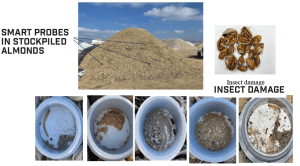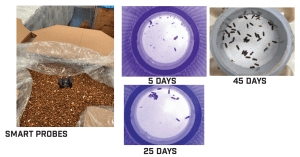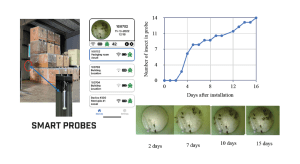
Insect infestation commonly occurs in food and agricultural products, including all nuts, during storage, stockpiling, processing, packaging and transportation. It can lead to several problems, including economic loss, health risks, product quality deterioration, adverse environmental impact and spread of invasive species. Infestations can cause significant economic losses to farmers, food producers and handlers as a large portion of their crops or stored food may become damaged or unmarketable.
Some insects carry pathogens that can cause serious health problems for humans and animals. In addition, insect bodies and excrement can contaminate food, leading to food poisoning and other safety concerns. Infestations can result in reduced quality of products, making them less appealing to consumers and lowering their market value. The use of fumigants and chemicals to control insect infestations can have negative impacts on the environment, worker health and food safety. Some insects can be invasive species that can spread to new areas and cause further infestations and environmental damage. Therefore, effective control of insect infestations in food and agricultural products is very important for food and agricultural industries and businesses as well as consumers.
Current Insect Detection Methods
There are several ways to detect insects in food and agricultural products, including 1) visual inspection, 2) traps, 3) X-rays, 4) infrared scanning, 5) acoustic detection and 6) DNA analysis. Visual inspection and traps have been used by industry, and the other four methods have not been used in practices due to their limited applicability and high costs. Visual inspection is the most common method used in nut industry and involves people simply looking for the presence of insects or their damage to food. It is time-consuming and inaccurate. Often insects cannot be detected until the population is large and significant damage has occurred.
Insect traps, such as sticky traps or pheromone traps, are used to attract and capture insects. They are placed in spaces in processing and storage facilities but require regular human inspections to detect and identify insects. X-rays were studied to detect insects inside packaged food products as they would show up as dark shapes on the X-ray image.
Infrared scanning is used to detect insects by measuring the temperature differences between the insects and their surroundings. Acoustic detection recognizes distinct insect sounds when they move or feed, and these sounds using specialized equipment such as microphones or vibration sensors. Insects can also be detected through DNA analysis of food or agricultural products, where samples are taken and analyzed for the presence of insect DNA.
Using the current visual inspection method, people usually cannot find the insects until the insect population is large, which causes significant damage to products. Our study has shown that in a warm environment at around 30 degree C, one insect caused damage to 23 kernels when it was in 100 almonds over three weeks.
To prevent product damage and quality loss, processors and handlers may need to frequently apply chemical fumigation to kill the insects. There are several problems associated with chemical fumigation. Fumigants can be highly toxic to workers if not used properly. Exposure to fumigants can cause respiratory problems, headaches, nausea and, in severe cases, death. Fumigants can be harmful to the environment, and repeated use of fumigants can lead to the development of resistance in pests, which can make the treatment less effective over time. Fumigation is expensive, especially if large structures or volumes of products are treated. Moreover, there are no effective tools to determine appropriate fumigation timing, dosages and effectiveness, which results in inappropriate fumigation treatment, unnecessary product loss and cost. The insect activities, product quality and safety are affected by the environmental conditions such as temperature and relative humidity. Effective tools for detecting the insects early as well as monitoring environmental conditions are needed to enable food and agricultural industry to control insects effectively and reduce the chemical use and cost.

SmartProbe Technology
With support from Almond Board of California and California Rice Research Board, we have developed and commercialized a new SmartProbe technology for early insect pest detection and environmental monitoring (See Figure 1) (patent pending, UC Davis). The technology has the capability of early detection of various types of insects once they emerge in food and agricultural products. The SmartProbe remotely monitors the activities of insects and alerts managers of storage and processing facilities to take proper actions for controlling the insects. It also monitors the temperature and relative humidity of stored products.
The system has two main components: a smart probe for insect detection and environmental monitoring and software with functions of cloud computing, data storage and alerting. The SmartProbe attracts insects, allows them to enter a collecting chamber, and then take photos to capture their images. It is programmed to take images periodically through the mobile device application or a computer.
The SmartProbe also has sensors to record temperature and relative humidity. The taken images and recorded data are sent automatically to a server where images are saved and processed with an accounting algorithm to count the insects captured. The data relating to the number of insects, temperature and relative humidity are then sent to the user interface to be viewed at any time, and alerting notifications are transmitted to the facility managers when necessary. Different types of probes were developed for use in bins/boxes, silos/stockpiles and hanging in processing and storage facilities.
The new SmartProbe technology provides convenient, reliable and low-cost tools for effective pest management of tree nuts and other products. It can be a very useful tool for making fumigation and other insect control measures more effective. The SmartProbe technology received the AE50 Outstanding Innovation Award from the American Society of Agricultural and Biological Engineers. Now the probes are commercially available from AIVision Food, Inc.

SmartProbe Technology Demonstration Results
The SmartProbe technology has been demonstrated and used at almond, walnut, pistachio and rice processing and storage facilities. The results showed it was able to detect various types of insects as they emerged in the tested products while human visual inspection failed to detect. For example, the SmartProbes detected insects in in-hull almonds during the stockpiling, which included the larvae of navel orangeworm, red flour beetles, bugs and moths, and simultaneously recorded the temperature and relative humidity of stockpiled almonds (See Figure 2). The probes also detected insect activities in packaged almonds. For instance, insects were detected in the fiber bin of the almond products after five days of the probe installation (See Figure 3). Additionally, the SmartProbe was able to detect insects in the processing and packing rooms of the almonds (See Figure 4).
The SmartProbe can be placed in products held in packages, storage bins, containers and stockpiles. The early detection and notification of insect infestation can solve common problems in pest management, such as product and quality loss, inappropriate amount of chemical use, food safety and workers’ safety concerns and high management costs.

Applications and Benefits of SmartProbe
SmartProbe can be used to remotely detect insects early and monitor environmental conditions in various food and agricultural products during storage, processing, handling and transportation/shipping, eliminating the cost of human inspection and associated risks.
SmartProbe can be placed in products in packages, bins, shipping containers, warehouse storage and bulk products.
SmartProbe is the only fully demonstrated smart technology for remote insect detection and available for commercial applications.
The early insect detection and notification avoid or minimize the loss in nut products and quality, enable new and effective pest management methods with reduced chemical use, cost and negative impacts on food safety, workers’ health and the environment.
The application of SmartProbe can make fumigation more effective, eliminating the guesses in fumigation time. SmartProbe can be an effective tool for determining the appropriate dosages of fumigants and assessing the effectiveness of fumigation. It makes fumigation only to the infested products possible.















